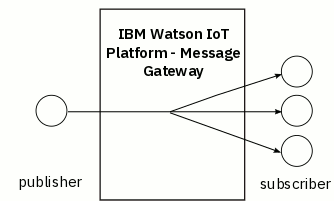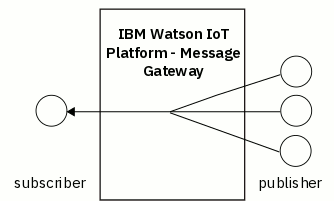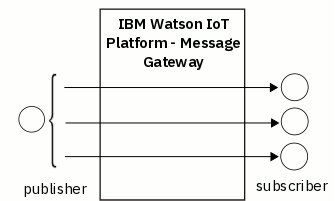Messaging patterns
The messaging patterns identify common message flows that are used in messaging solutions. There are five messaging patterns: fan out broadcast, fan in per device notification, fan out per device notification, fan out per device request-reply, and fan in per device request-reply.
Fan out broadcast
One publisher device publishes a message to a topic string. The messages have many subscriber devices.

Fan in per device notification
Many publisher devices publish messages to a topic string. The messages have one subscriber device.

For an example implementation of this pattern, see Scenario 2: Fan in per device notification
Fan out per device notification
One publisher device publishes messages to many topic strings. Each message has only one subscriber device.

For this messaging pattern,
each subscriber must subscribe to a unique topic. By using the unique
user ID, group ID or client ID of the subscribing application in the
topic string, you can ensure that each topic is unique. For example,
a subscriber application instance that connects with a client ID of 123 subscribes
to RESPONSE/123. A subscriber application instance
that connects with a client ID of 456 subscribes
to RESPONSE/456. A subscriber application instance
with a client ID of 789 subscribes to RESPONSE/789.
//Generate clientID
String clientID = String.format("%-23.23s", UUID.randomUUID().toString()).trim().replace('-', '_');
//Create an MQTT client with the generated clientID
MqttClient mobileClient = new MqttClient("tcp://MessageSightHostName:MessageSightEndpointPort", clientID);
//Subscribe to the RESPONSE/${ClientID} topic
mobileClient.subscribe("RESPONSE/"+clientID, 0);To
ensure that subscribers cannot access the topics of other subscribers,
you can use the topic string variable substitution available in the Eclipse Amlen messaging policies.
By using topic string variable substitution you can create a messaging
policy with single topic string that includes a user ID, group ID
or client ID variable. This substitution ensures that applications
can subscribe only to the topic string that matches their user ID,
group ID or client ID. For example, a topic string of RESPONSE/${ClientID} is
specified in the messaging policy. The application with a client ID
of 123 is allowed to subscribe to RESPONSE/123,
but is not allowed to subscribe to RESPONSE/456,
or RESPONSE/789 because the client ID does not match.
For more information about messaging policies and variable substitution,
see Authorizing client messaging.
For an example implementation of this pattern, see Scenario 3: Fan out per device notification.
Fan out per device request-reply
One publisher device publishes messages to many topic strings. Each topic string has only one subscriber device. Each subscriber device publishes reply messages on a separate topic string. The publisher device subscribes to all the reply topics.

For an example implementation of this pattern, see Scenario 4: Fan out per device request-reply.
Fan in per device request-reply
Many publisher devices publish messages to many topic strings. A single subscriber device subscribes to all of the topic strings. The subscriber device publishes reply messages on separate topic strings for each publisher device.

For an example implementation of this pattern, see Scenario 5: Fan in per device request-reply.